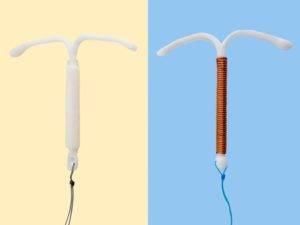What’s an IUD?
An IUD is a tiny device that’s put into your uterus to prevent pregnancy. It’s long-term, reversible, and one of the most effective birth control methods out there.
What does IUD stand for?
IUD stands for Intrauterine Device (basically: a device inside your uterus). It’s a small piece of flexible plastic shaped like a T. Sometimes it’s called an IUC — intrauterine contraception.
What are the types of IUDs?
There are 5 different brands of IUDs that are FDA approved for use in the United States: Paragard, Mirena, Kyleena, Liletta, and Skyla.
These IUDs are divided into 2 types: copper IUDs (Paragard) and hormonal IUDs (Mirena, Kyleena, Liletta, and Skyla).
Copper IUDS
How effective are copper IUDs when used as emergency contraception?
ParaGard is an intrauterine device (IUD) that can provide long-term birth control (contraception). It’s sometimes referred to as a nonhormonal IUD option.
The ParaGard device is a T-shaped plastic frame that’s inserted into the uterus.
How you prepare: ParaGard can be inserted anytime during a normal menstrual cycle. If you just had a baby, your doctor might recommend waiting about eight weeks after delivery before inserting ParaGard.
Before inserting ParaGard, your health care provider will evaluate your overall health and do a pelvic exam. You may have a pregnancy test to confirm you’re not pregnant, and you may be screened for STIs. Also, taking a nonsteroidal anti-inflammatory drug, such as ibuprofen (Advil, Motrin IB, others), one to two hours before the procedure can help reduce cramping.
How does it work?
Copper wire coiled around the device produces an inflammatory reaction that is toxic to sperm and eggs (ova), preventing pregnancy. ParaGard is the only copper IUD available in the United States.
Therefore, it is one of the most effective method of emergency contraception available. If you get it within 120 hours (5 days) after having unprotected sex, it’s more than 99.9% effective at preventing pregnancy. It can prevent pregnancy for up to 10 years after insertion.
Hormonal IUDs
Hormonal IUDs are inserted in a similar fashion as the copper IUD. A licensed trained practitioner can only administer these.
The Mirena, Kyleena, Liletta, and Skyla IUDs use the hormone progestin to prevent pregnancy. Progestin is very similar to the hormone progesterone that our bodies make naturally.
Types of Hormonal IUDs
Mirena
The Mirena device is a T-shaped plastic frame that’s inserted into the uterus, where it releases a type of the hormone progestin. To prevent pregnancy, Mirena thickens mucus in the cervix to stop sperm from reaching or fertilizing an egg. It also thins the lining of the uterus and partially suppresses ovulation. In addition, Mirena is also used for the treatment of heavy menstrual bleeding in women. Mirena prevents pregnancy for up to five years after insertion. It’s one of several hormonal IUDs with Food and Drug Administration approval.
Kyleena
The Kyleena IUD consists of a soft, flexible plastic frame in the shape of a T. As a way to prevent pregnant, this IUD slowly releases progestin into the uterus over a period of 5 years. This hormone promotes thinning the lining of the uterus, thickening of cervical mucus, which inhibits sperm movement and reducing sperm survival.
The Kyleena IUD contains 19.5 mg of progestin, levonorgestrel. It releases 17.5 mcg of this hormone per day. After one year, this rate slowly declines to 9.8 mcg daily, and then to 7.4 mcg per day. It is FDA-approved for use in women who have or have not give birth. It’s one of several hormonal IUDs with Food and Drug Administration approval.
Liletta
Liletta is a small, flexible plastic T-shaped system that slowly releases a progestin hormone called levonorgestrel (LNG) that is often used in birth control pills. Because Liletta releases LNG into your uterus, only small amounts of the hormone enter your blood. Liletta does not contain estrogen.
Two thin threads are attached to the stem (lower end) of Liletta. The threads are the only part of Liletta you should feel when Liletta is in your uterus. However, unlike a tampon string, the threads do not extend outside your body.
So, Liletta is very similar to the Mirena IUD except that Liletta is currently approved to be effective for up to 3 years and isn’t used to treat heavy menstrual bleeding in women like Mirena. It’s one of several hormonal IUDs with Food and Drug Administration approval.
Skyla
Sklya is very similar to Liletta and Mirena with the shape and how it is inserted, however the amount of hormone being released is slightly different. For instance, Skyla initially releases 14 mcg of levonorgestrel per day and can be used for up to three years. It’s one of several hormonal IUDs with Food and Drug Administration approval.
To break it down:
- Mirena initially releases 20 mcg of levonorgestrel per day and is FDA-approved for up to five years.
- Liletta initially releases 19.5 mcg per day of levonorgestrel and is approved for four years of use.
- Skyla initially releases 14 mcg of levonorgestrel per day and can be used for up to three years.
- Kyleena initially releases 17.5 mcg of levonorgestrel per day. It can remain in place for five years.
Here we broke down the different types of IUDs and explained their efficacy. However, no birth control is 100% effective besides abstinence. In a rare case of pregnancy while on these different birth control methods, know that there options to terminate the pregnancy. Consult with your provider to better understand which method would be best for you and your body. In conclusion, you can see one of our providers here at Garden State Gynecology to inquire about IUDs or to talk about a more permanent birth control method. Call to make an appointment today!

